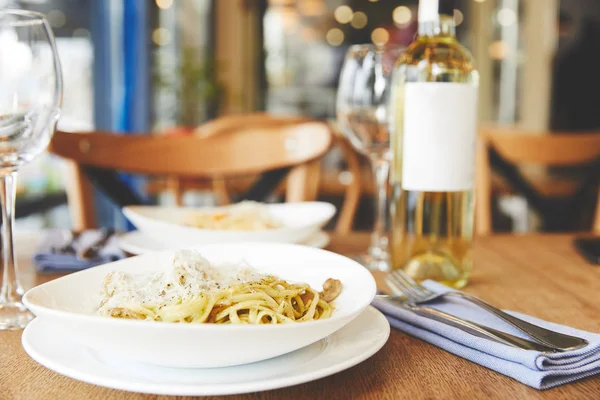Italy might look like just another European destination on your travel map, but set foot in Rome, Florence, or any Italian city, and you’ll quickly realize the locals operate by a completely different social playbook. These aren’t just cultural quirks or tourist traps—they’re deeply ingrained traditions that every Italian follows without question, while visitors scratch their heads wondering what they did wrong.
From the moment you order your first coffee to the way you greet strangers on the street, Italy has unspoken rules that can make or break your experience. Here is a list of 16 Italian social rules that leave every visitor feeling like they’re playing a game where nobody explained the rules.
Never Order a Cappuccino After 11 AM

Italians treat cappuccino like breakfast cereal—it belongs in the morning and nowhere else. Walk into any Italian café after 11 AM and order a cappuccino, and you’ll get looks like you just asked for ketchup on your pasta. The logic is simple: milk-based drinks are considered too heavy for later in the day, especially after meals. Italians believe the milk interferes with digestion when consumed after lunch or dinner.
If you want coffee after 11 AM, stick to espresso, which Italians simply call ‘caffè.’
Don’t Sit Down for Coffee

Coffee culture in Italy happens at lightning speed, and sitting down for your morning caffè is like taking a luxury spa day when everyone else is rushing to work. Italians drink their espresso standing at the bar counter, usually finishing it in two or three sips before heading out the door.
The whole experience takes maybe three minutes tops. Sitting down for coffee not only costs more (bars charge extra for table service), but it also marks you as a tourist who doesn’t understand the Italian rhythm of life.
Like Travel Pug’s content? Follow us on MSN.
Never Break Pasta

Italians have a sacred relationship with pasta, and breaking long noodles before cooking them is like vandalizing the Sistine Chapel. The pasta is designed to be a specific length for a reason—it affects how the sauce clings to it and how it feels in your mouth. Breaking spaghetti or linguine shows a fundamental misunderstanding of Italian cooking philosophy.
Instead, Italians twirl the pasta around their fork using a spoon as support, creating perfect little nests. If you can’t handle long pasta, order a shorter shape like penne or rigatoni.
Don’t Add Cheese to Fish Pasta

Mixing cheese with seafood pasta is one of the fastest ways to horrify an Italian chef. This rule runs so deep that most Italian restaurants won’t even offer you Parmesan when you order dishes like spaghetti alle vongole or linguine with shrimp. The reasoning is that cheese overpowers the delicate flavor of the seafood, creating a clash that Italians consider completely unappetizing. It’s like putting sugar in your wine—technically possible, but culturally unthinkable.
The natural flavors of the ocean should speak for themselves.
Always Greet Shopkeepers

Walking into an Italian shop without saying ‘buongiorno’ or ‘buonasera’ is like entering someone’s home without knocking. Italians consider this basic politeness, and skipping the greeting marks you as rude or disrespectful. Even if you’re just browsing, that initial greeting establishes a connection between you and the shopkeeper.
When you leave, you’re expected to say ‘arrivederci’ or ‘buona giornata,’ regardless of whether you bought anything. This isn’t just about manners—it’s about acknowledging the other person’s humanity and showing respect for their space.
Like Travel Pug’s content? Follow us on MSN.
Never Rush Through Meals

Italians treat meals like sacred ceremonies, and wolfing down your food is like speed-reading poetry—you’re missing the entire point. A proper Italian meal unfolds slowly, with distinct courses that each have their moment to shine. Rushing through antipasti to get to the main course shows you don’t understand that eating is about more than just filling your stomach. It’s about conversation, connection, and savoring each flavor.
Even a simple lunch can stretch for an hour or more, and dinner often lasts two to three hours.
Don’t Wear Flip-Flops in the City

Italians dress like they’re always ready for a fashion photoshoot, and showing up in flip-flops is like wearing pajamas to a business meeting. Even on scorching summer days, you’ll see Italian men in leather shoes and women in stylish sandals that actually support their feet. Flip-flops are reserved for the beach or poolside, not for walking through historic city centers or dining at restaurants.
Italians believe your appearance reflects your respect for the people and places around you. Comfortable doesn’t mean sloppy.
Always Eat Pizza with Your Hands

Despite their reputation for proper table manners, Italians abandon forks and knives when it comes to pizza. Using utensils to eat pizza marks you as either overly formal or completely clueless about Italian food culture. The crust is designed to be sturdy enough to hold the toppings, and eating it with your hands allows you to experience the full texture and temperature of each bite.
Even in upscale restaurants, you’ll see well-dressed Italians folding their pizza slices and eating them with their fingers. It’s not messy—it’s authentic.
Like Travel Pug’s content? Follow us on MSN.
Never Order Risotto as a Side Dish

Risotto isn’t rice that happened to get creamy—it’s a complete dish that deserves its own moment in the spotlight. Ordering risotto alongside a main course is like ordering two entrées at once, something that confuses Italian servers and chefs. Risotto requires constant stirring and precise timing, making it a dish that’s meant to be savored on its own.
Italians typically eat risotto as a primo piatto (first course), followed by a lighter secondo piatto (second course) like grilled fish or meat. Treating risotto as a side dish misses the point entirely.
Don’t Overdo the Affection

Italians have a reputation for being passionate and expressive, but public displays of affection follow strict unwritten rules. While friends greet each other with kisses on both cheeks, romantic couples keep their passionate moments private. Excessive kissing, hugging, or touching in public places makes Italians uncomfortable, especially in more conservative areas or religious sites.
The key is reading the room—a quick kiss hello is fine, but extended make-out sessions belong behind closed doors. Italians separate public social behavior from private romantic expression.
Always Bring a Gift When Invited

Showing up empty-handed at an Italian’s home is like arriving at a potluck without bringing a dish. Italians take hospitality seriously, and when someone invites you over, they’re likely spending hours preparing food and creating a welcoming atmosphere. Bringing a small gift—flowers, wine, or dolci from a local pasticceria—shows you understand and appreciate their effort.
The gift doesn’t need to be expensive, but it should be thoughtful. Even a simple bouquet demonstrates that you value the invitation and respect Italian customs.
Like Travel Pug’s content? Follow us on MSN.
Never Start Eating Before Everyone is Served

Italians view mealtime as a collective experience, and digging in before everyone has their food is like starting a movie before all your friends arrive. This rule applies whether you’re at a family dinner or a restaurant with friends. Everyone waits until the last person receives their dish before anyone takes the first bite.
It’s about solidarity and shared experience—the meal is meant to be enjoyed together, not individually. This patience extends to each course, where the next round doesn’t arrive until everyone has finished the previous one.
Don’t Expect Ice in Your Drinks

Italians believe ice dilutes flavors and shocks your digestive system, treating it like a dangerous additive rather than a refreshing addition. Most restaurants serve drinks at room temperature or slightly chilled, and asking for extra ice often results in a few sad cubes floating in your glass. This applies to everything from wine to water to soft drinks. Italians think Americans are obsessed with ice to an unhealthy degree.
The preference for room temperature drinks is tied to their belief that extreme cold interferes with digestion and masks the true taste of beverages.
Always Remove Your Hat Indoors

Taking off your hat when entering buildings, especially churches or restaurants, is considered basic respect in Italian culture. Keeping your hat on indoors suggests you’re either ignorant of local customs or deliberately being disrespectful. This rule applies to baseball caps, beanies, and any other head covering except for religious purposes. Italians see hat removal as acknowledging the sacred or formal nature of indoor spaces.
Even in casual settings like cafés or shops, removing your hat shows you understand the difference between outdoor and indoor behavior.
Like Travel Pug’s content? Follow us on MSN.
Never Put Oil in Pasta Water

Adding oil to pasta water is like putting training wheels on a professional bicycle—it suggests you don’t understand how the equipment actually works. Italians believe oil prevents the sauce from properly adhering to the pasta, creating a slippery surface instead of the slightly rough texture that holds flavors.
The key to preventing pasta from sticking is using enough water, stirring occasionally, and timing everything perfectly. Oil belongs in the sauce or is drizzled on the finished dish, not floating around in the cooking water where it serves no useful purpose.
Don’t Expect Substitutions

Italian restaurants operate more like museums than fast-food joints—the dishes are carefully crafted compositions that shouldn’t be altered. Asking to substitute ingredients or modify preparations is like asking a painter to change the colors in their masterpiece.
Chefs create their menus based on traditional recipes, seasonal ingredients, and flavor combinations that have been perfected over generations. If you don’t like something on the menu, order something else rather than trying to customize it. This isn’t stubbornness—it’s pride in culinary tradition and respect for the craft.
The Rhythm of Italian Life

These social rules might seem overwhelming at first, but they’re really about understanding the Italian approach to life—one that prioritizes quality over speed, tradition over convenience, and connection over efficiency. What confuses visitors is actually the foundation of a culture that has maintained its identity for thousands of years.
Once you start following these unwritten guidelines, you’ll find that Italians become much more welcoming and your experience becomes infinitely richer. The rules aren’t meant to alienate travelers—they’re invitations to engage with a culture built on respect, tradition, and the simple pleasure of doing things with care.
Like Travel Pug’s content? Follow us on MSN.
More from Travel Pug

- 20 Best Beach Towns in the Carolinas
- 13 Destinations Where Tourists Regularly Regret Their Trip
- 20 Things You Actually Get in First Class
- 20 Small Airports With Aviation Museums
- 20 Places in the U.S. That Are Perfect for a Reset Trip
Like Travel Pug’s content? Follow us on MSN.
